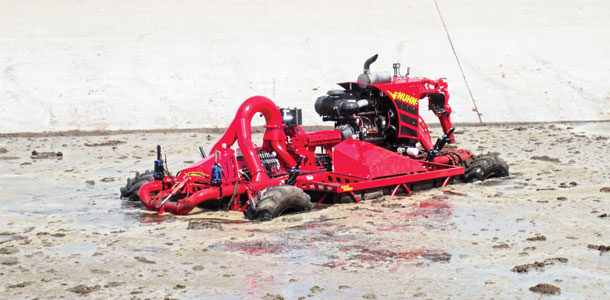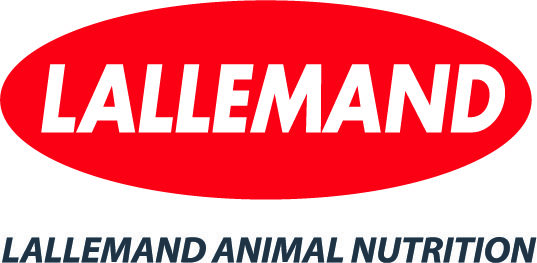It’s not just storage size that has changed, though; the consistency and content of manure has changed, too. On some farms, using traditional equipment – agitation units that are placed along the edge of a storage unit – no longer provides adequate sediment disturbance and has created the need for something better.
As a result, a number of options have hit the market in recent years. Arguably, though, the most intriguing and effective solution has been the agitation boat.
Choosing the right equipment for the job
Since proper agitation provides both precise and uniform results, choosing the right equipment for the job is absolutely crucial. To choose the right agitation equipment for your farm, first consider the quality of manure in storage and the size of your storage facility.
Manure varies from farm to farm and is dependent on factors like animal type, diet and the addition of byproducts like runoff and bedding material.
“Manure has changed, particularly in dairies, where we’re seeing lower solids,” says Dr. Becky Larson, assistant professor and extension specialist, biological systems engineering, University of Wisconsin.
“In general, we’ve been seeing a lot more liquid samples now that we’re adding waste from the milking parlour, runoff, silage leachate, etc.,” she says. “With all of these different sources from around the farmstead going into the manure pit, it can be very different from one facility to the next.”
How manure settles depends heavily on how much solid waste it contains and what type of bedding is used. Solids and valuable nutrients, for example, will settle at the bottom of the pit, creating stratification.
The move to larger storage facilities has also changed the way manure is handled. Some storage facilities, for example, have reached a capacity of 25 million gallons.
Typical agitation methods, where equipment is lowered in at one (or more) of the edges, don’t reach far enough into the pit to re-suspend all of the sediment, particularly in the middle.
“The more settling we see, the more agitation you need. Thicker manure is sometimes harder to get re-suspended,” Larson says. “You need more power, more effective mixing to get things to re-suspend.”
In recent years, dairy farmers have made the switch to sand bedding. Sand, though, presents additional challenges because it settles and remains in the pit even when manure is pumped off. To get rid of settled sand, producers hire contractors who physically scrape and dig out the remaining buildup.
The process can be quite costly. To remove sand from a lagoon for 100 cows, for example, it can cost as much as $10,000. For larger operations, sand removal can produce an even larger bill. Using agitation boats, though, producers can remove sand while agitating, which can amount to considerable savings.
Since the switch to sand bedding, sand buildup in lagoons is a serious and relatively new problem. It’s not just a problem for operations with lagoon storage, though. It also poses problems for producers who use round, straight-wall, concrete pits.
Another benefit of using an agitation boat is that it can address the sand issue in both systems. There are, in fact, even serious custom operators who are craning the boats into straight-wall pits.
Agitation boats offer benefits
When it comes to agitation boats, there are a number of options available to producers. Some merely agitate, but most are capable of loading as well. Of the models currently on the market, all are self-propelled using a remote control, although some are working on GPS capabilities.
While most agitation boats are loaded into lagoons or slurry pits manually with a tractor or loader, one unit on the market is outfitted with drive wheels that allow it to drive in and out of the lagoon itself. This feature also enables it to maneuver through thick, tough lagoons where standard boats can get stuck.
Perhaps where we see the most design variation is in pumping capacity. Current models can pump anywhere between 2,000 and 10,000 gallons per minute.
Fuel consumption varies, too. While some boats use as little as 4.5 gallons per hour, others use as much as 12 gallons per hour, particularly when working in the thickest parts of a sandy lagoon.
Agitation boats offer producers a variety of perks, including increased accessibility that results in more thorough agitation and renewed capacity. Since agitation boats are operated remotely, they can reach locations other equipment can’t.
This is especially important on farms with larger storage units. Larson says there is evidence to support the idea that the more agitation you do, the more uniform manure samples will be. And the more uniform your samples are, the less often you’ll need to sample.
Maintaining consistency is critical for environmental health, particularly when it comes to nitrogen loss, and providing uniform application rates for crop needs. Application rates are determined by manure analysis results; where inconsistencies exist, overapplications or underapplications are possible.
“If you have all of these inconsistencies and you aren’t sampling constantly, which pretty much nobody is, your results can be very inaccurate,” Larson says. “The closer we can get to being accurate, the bigger impact on yield.
“You’re not just reaching the edge of the pit; you can reach all over the place,” Larson says of using an agitation boat. “And we’ve found that the higher-solids content samples definitely have had more variation. In those cases, having the boat, which seems to be able to agitate a little more effectively in some situations, might be beneficial.”
Producers particularly like the fact that agitation boats can be operated remotely. In terms of safety, this is a huge benefit, since it means they no longer have to operate equipment in close proximity to the pit, thereby avoiding harmful gases.
Finally, thorough agitation is also necessary for maintaining storage capacity. In the online forum, AgChat, producers have talked openly about the perks of owning agitation boats. Throughout the thread, one theme is common: cleanliness.
“[It] really gets the pit clean,” writes one producer. “The manure pit has not been that empty since it was built,” says another. PD
Melanie Epp is a freelance farm writer from Guelph, Ontario. She wrote this article on behalf of Nuhn Industries.









